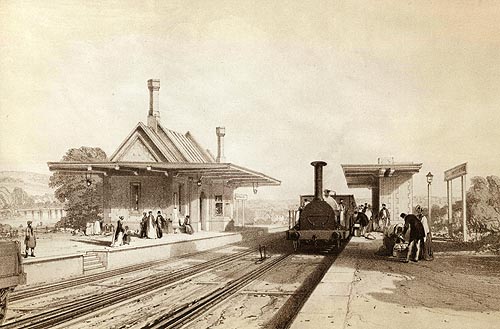5? try 7'0¼"

I'm not sure why the ¼", but if Isambard Kingdom Brunel thought it was necessary, there was probably areason for it.
Posted on 11/10/2012 7:13:35 AM PST by InvisibleChurch
The US standard railroad gauge (distance between the rails) is 4 feet, 8.5 inches. That’s an exceedingly odd number.
Why was that gauge used?
Because that’s the way they built them in England, and English expatriates built the US Railroads.
Why did the English build them like that?
Because the first rail lines were built by the same people who built the pre-railroad tramways, and that’s the gauge they used.
Why did “they” use that gauge then?
Because the people who built the tramways used the same jigs and tools that they used for building wagons, which used that wheel spacing.
Okay! Why did the wagons have that particular odd wheel spacing?
Well, if they tried to use any other spacing, the wagon wheels would break on some of the old, long distance roads in England, because that’s the spacing of the wheel ruts.
So who built those old rutted roads?
(Excerpt) Read more at aviationhumor.net ...
If water is available cargo ships beat trains. Maybe robotic blimps would beat them all. Fuel efficiency comparisons never seem to factor in speed differences. If a 747 slowed down to 150 mph and a freight train sped up to that speed, the 747's fuel efficiency would blow the train away. In theory fuel efficiency for all modes of transport approaches infinity as speed approaches zero.
Wow, that's really narrow! ≤}B^)
I find the 2-foot Ffestionog & Welsh Highlands roads especially charming. Seems right out of Dickens--or Harry Potter.
Standard gauge, sure. And I guess railroads may have shared terminals in smaller cities or towns. But in larger cities different railroads did have different passenger terminals.
I don't know about freight terminals or links between the terminals of different lines. Maybe somebody else has more information.
The cross-loading of freight and passengers between different gauge roads was turning out to be an intolerable inefficiency. All the standard-gauge roads had adopted free roaming of freight cars, meaning that contractual arrangements existed that allowed any road's car to travel anywhere in the rail network. Of course, standards were created and had to be met, and accounting practices put into place to track the cars and allocate per diem charges.
So the nonstandard gaugers knew that they had to re-gauge. They got together and prepared for an effort that had to be as rapid as possible. New rolling stock was ordered and some was converted. Tens of thousands of extra men were hired and at the ready.
In the case of the Atlantic and Western (the line of the Great Locomotive Chase), they converted their 138 miles in a 24-hour period beginning on 31 May, 1886. I believe this was the date that other southern roads did likewise.
I think that qualifies as the Unix Hacker's proverbial long weekend.
Certain large cities were blessed with a multitude of passenger terminals (Chicago once had seven). Of course with most of the stations scattered, this was simply a curse for the passenger connecting through the city on lines with different terminals.
Chicago retains four terminals scattered around the periphery of the Loop, plus Els and subways, and you have to walk (or cab or bus) among them if the Loop is not your destination. There has been (mostly idle) talk in recent decades about a rapid-transit ring connecting the stations, but it's simply going to be too expensive, at least in this cycle of the Universe.
Heh, and uh-boy. :’) Thanks Hegemony Cricket.
Horse’s Pass
Claim: The United States standard railroad gauge derives from the original specification for an Imperial Roman war chariot.
Status: False.
http://www.snopes.com/history/american/gauge.asp
Was standard railroad gauge (4’81â„2”) determined by Roman chariot ruts?
February 18, 2000
http://www.straightdope.com/columns/read/2538/was-standard-railroad-gauge-48-determined-by-roman-chariot-ruts
There have long been campaigns for a "North-South Rail Link" but nothing ever comes of it -- or is likely to after the major highway project "The Big Dig" wasted all that money.
New York uses Grand Central for commuter rail and (what once was) Penn Station for Amtrak. Years ago, though, some lines stopped at Hoboken across the river in New Jersey.
Back in Civil War times, though, cities were smaller and more of them may have had only one station than they had in the postbellum golden age of railroading. Now a lot of cities may be lucky if one working station survives.
stepping stones in pompeii
When I was stationed in Korea, I ended up extending my tour twice to serve a total of three years there. In the ROK, where the single soldier tour is only one year, and command sponsored, accompanied tours are two years, that made me a vertiable institution. My tour overlapped three brigade commanders and three batallion commanders. What was funny is that I saw a whole lot of stuff changed, only to be returned to the way it was when I arrived.
Some people implemented changes simply to "leave their mark." In other areas, it became highly evident why some things, "had always been done that way," and needed to remain so.
There was no danger of chariots overturning in battle because the Romans did not use chariots in battle. Chariots were not used for transportation (except in the movie adaptation of A Funny Thing Happened on the Way to the Forum).
The German tanks in World War II were larger and heavier than US tanks. Eisenhower wanted bigger tanks but couldn’t get them. They would not have been able to get to the east coast docks from the converted auto factories in Detroit. Like the SRBs, the train tunnels were too narrow.
Also, in the US the ends of each rail is alternated (left, right, left, etc) and produce the familiar "clickity clack" sound. The ends of Russian rails are simultaneous and produce an endless series of thuds.
My kids got so sick of the 5 whys that even now when I try to walk them through a thought process, they just ask to speak to my wife.
But, I made a ton of money using those simple ideas. It just seems that too many people cannot see past the end of their noses.
5? try 7'0¼"

I'm not sure why the ¼", but if Isambard Kingdom Brunel thought it was necessary, there was probably areason for it.

No, you got to put rail on them if you did!! However, as a RAILFAN (since the day of the New Haven going through my town with 100+ cars), I would love to see Railroad Mileage increase in the US (but without support of the Government).
My friend took over an Abandoned branch of the New Haven and he is successful with it. We shouldn't write off rail, yet!!
Disclaimer: Opinions posted on Free Republic are those of the individual posters and do not necessarily represent the opinion of Free Republic or its management. All materials posted herein are protected by copyright law and the exemption for fair use of copyrighted works.